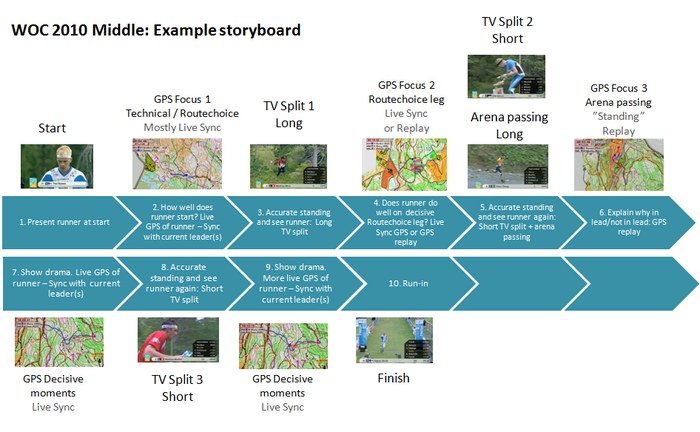From OTV
Contents |
Storytelling
Storytelling can be defined as the way the different elements in a TV broadcast are put together in order to tell a story and bring forward the drama to the viewers.
Storytelling - best practice
Conclusions from the SOFT TV Workshop in February 2012:
- Storytelling with emotions and drama + profiles are key ingredients in any TV broadcast from orienteering
- There is too much "orienteering" GPS-tracking, too little "journalistic" GPS-tracking. Need GPS-tracking operators that can follow the drama, not only master the technicalities
- Time-keeping, graphics and other technicalities must work. There are big opportunities for orienteering on TV, but focus must be put on a standarized product for producers and commentators, and the end-product must be reliable for the customers.
- The timeline for productions must be set in a way which there is time for the commentator to discuss and explain
- A good startlist is very important for the storytelling; sprint -> should have 2 minutes between each top runner. long -> need two minute start interval and a real red group.
- Work needs to be done on the technical side to investigate possibilities to get “athlete tracking” to work in sprint (via GPS or alternative method)
Example: WOC 2010 Middle
To exemplify this, an example has been made for WOC 2010 Middle (see a simplified storyboard below).
Scene types
For the WOC 2010 Middle case, the main scenes in the story are
- TV footage at start, at 3 different TV splits, at arena passing and last control/run-in/finish
- Different types of GPS tracking scenes with different focus and visualization type for the different GPS tracking scenes
- Other scenes (e.g. cheering spectators, preproduced material - not included in the simplified storyboard below)
There are many other elements which are also part of the storytelling, like e.g. choice of camera angles, type of camera footage, pre-recorded route choice analysis, interviews, etc. These are not included in the sample storyboard below. For a breakdown of key elements see this discussion on "Key Elements".
Storyboard
Based on the scenes, a storyboard can be defined. This storyboard describes which scenes to show in which order in the ideal case. Here a simplified storyboard example is set up for a single runner (Note! This is not the actual storyboard for the production, just an example set up based on looking at the footage from the event in retrospect):

The producer will of course not be able to follow the ideal case for a single runner, as there are around 50 starters and you always have to choose which runner to show to not miss the most important scenes.
Scene prioritization
In addition to the storyboard, one therefore needs a philosophy on how much to show of each type of scene, and which scenes to prioritize when there are conflicts. One example philosophy:
- Focus on the biggest favourites even if they fail
- Build up expectations by waiting for favourite with the clock running for 5-10 seconds
- Not tell more than you have to - i.e. you don't always have to show the viewer everything if it helps the storytelling
- Use the GPS tracking actively to explain exceptionally good / bad split times as soon as possible after the split time
Improvisation and compromises must be done all the way.
The challenge for a producer who does not have a lot of experience with orienteering, is to handle the orienteering specific scenes in a proper way. To use the interplay between camera footage and GPS tracking well in the storytelling - and exploit all of the possibilities in the GPS-tracking - is one of the important keys to get a good broadcast from an orienteering race.
Work notes (to be expanded later on)
Important elements:
- "Time to beat"
- Build excitement
- "Wait for runner"
- "Viewer knows more than runner"
- "Not tell more than you have to in some cases"
- Show runners in their correct element (in the forest)
- Identify profiles to build the story around; focus on their race and emotions even if the race is bad Also useful for pre production. Maybe more important for a national broadcast.
Comments about story-telling (Jørn S):
- Some parts in WOC 2010 was good, some parts of WOC 2008, the men in NOC 2005, NORT 2010 chasing start. Except for that there is often a long time without anything happens / without anything to be shown or it is shown too late.
- GPS Tracking: Very important to see GPS-tracking as part of the story-telling - find the right clips (fast) to show at the right time. Good work at WOC 2010 by Pål K.
- It is challenging for a GPS-operator to process all the information from the GPS-tracking and at the same time have control over the drama in the competition. A tool to automatically pick out specific scenes from GPS-data could be useful.